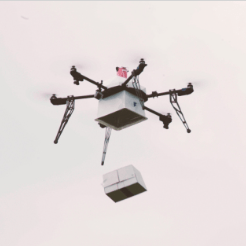
Since then, Flirtey has successfully tested both the first urban drone delivery – performed in Hawthorn, NV near the company’s Reno headquarters – and the first “ship to shore” drone delivery, in Cape May, NJ. All three demonstrations were performed in cooperation with NASA and the FAA, and went off without any problems – a significant move forward for the commercial drone industry.
In fact, the tests were so significant to the U.S. drone industry that Flirtey’s drone has been accepted to the Smithsonian National Air and Space Museum. But while those groundbreaking deliveries showed clearly the humanitarian benefit that drone delivery can provide, Flirtey CEO Matthew Sweeny told RoboticsTrends that previous tests were just stepping stones to home delivery. The company is already in discussions with potential customers, and Sweeny says that home delivery will start very soon – within one year.
“Within the next 12 months, Flirtey will be delivering packages from stores to people’s homes, commercially,” Sweeny told RoboticsTrends. “It will start incrementally and build up.”
Twelve months is an aggressive timeline, considering that the recently published Small UAS Rule – which took years for the FAA to release – does not allow for drone flight beyond visual line of sight (BVLOS) or over people, both necessary for widespread drone delivery. Despite the fact that Flirtey has worked closely with NASA and the FAA to perform sanctioned trials of drone delivery, Flirtey was vocal in its criticism of Part 107’s limitations, pointing out that the U.S. lags significantly behind other countries in commercial drone regulations.
The Flirtey drone uses technology to overcome safety concerns: features like an auto-return to home in case of signal loss or a safe return for low battery situations provide a level of security. Flirtey is already running a commercial drone delivery business in New Zealand, where regulations allow drone delivery – around the time that Flirtey was conducting the first delivery of medical supplies in rural Virginia, they were delivering the first parcel of auto parts in New Zealand – check out Flirtey’s video of that delivery below.
Miriam McNabb is the Editor-in-Chief of DRONELIFE and CEO of JobForDrones, a professional drone services marketplace, and a fascinated observer of the emerging drone industry and the regulatory environment for drones. Miriam has penned over 3,000 articles focused on the commercial drone space and is an international speaker and recognized figure in the industry. Miriam has a degree from the University of Chicago and over 20 years of experience in high tech sales and marketing for new technologies.
For drone industry consulting or writing, Email Miriam.
TWITTER:@spaldingbarker
Subscribe to DroneLife here.